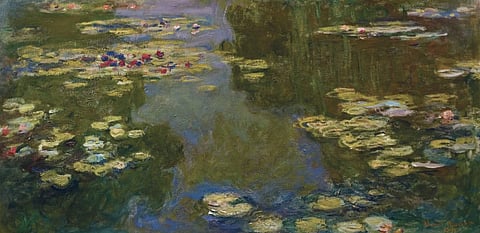

A few galleries in the Metropolitan Museum of Art in New York are dedicated to the riot of colours that are Claude Monet’s paintings. The incessant influx of tourists and art lovers make you stand and wonder as to what encaptivates them so. Some of us cannot get enough photographs of Monet’s waterlilies. Some of us try to get ourselves photographed alongside the celebrated paintings. What makes Monet a household name? Why isn’t he spoken of in a lecture on classic Western art? Why do the waterlilies command so much attention?
Claude Monet trained as an art student in Paris and Normandy, meeting with contemporaries such as Édouard Manet, Alfred Sisley, Frédéric Bazille and Camille Pissarro. These young artists had a penchant for painting en Plein air (outdoors), capturing lights and shadows in rough brushstrokes, often creating an impression of the scenery around them while most of their fellow art students developed their respective styles by copying from the old masters and their classics. This movement challenged the notions of what was considered traditional high art and came to be called as ‘Impressionism’, with Monet being one of its most famous founders. He continued to travel across Europe and was inspired by the informal sketches of Dutch painters. His journeys took him from a stint in the French army to Vétheuil where his paintings started to show a gradual departure from the classic realist expression to a smoother Impressionist style.
While his first works received flak for being non-conformist and challenging high art, his later works began to be recognised and even commissioned. The last thirty years of his life were dedicated to the painting of his beloved garden in Giverny where he personally oversaw the architecture and landscaping of a channel, waterlily ponds, Japanese bridges and orchards of willow trees. Declaring the garden to be one of his life’s finest works, Monet embarked on a series of approximately 250 paintings inspired by the garden itself, and more so, by the variety of waterlilies, he nurtured there. Many of his initial paintings were of smaller dimensions whereas the latter ones were extremely large murals. His cataract was quite a hurdle and interfered severely with his art productions. He did not let it get him down and he continued to produce his waterlily masterpieces that were particularly noted for the reflections in the lily ponds.
A close observation of his paintings will reveal that he did not compromise on even the tiniest detail. Each of the waterlilies in the ponds have their own reflections and the painstaking attention given to creating the impression of individual petals is unbelievable! His repetitive studies of the atmosphere and the garden environment at different times of the day, in different lights and climes, helped future artists glean a lot of information about capturing the essence of light and shadow through mere brushstrokes. Today, Claude Monet is the emblem of change and one of the earliest Impressionist maestros that we have come to love and emulate.
